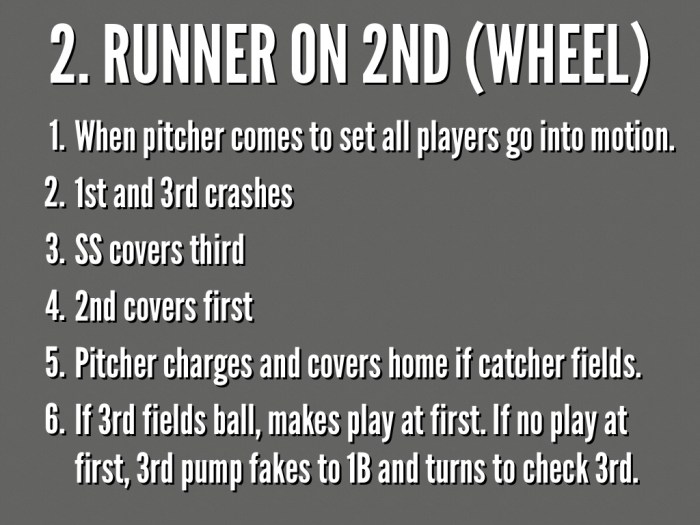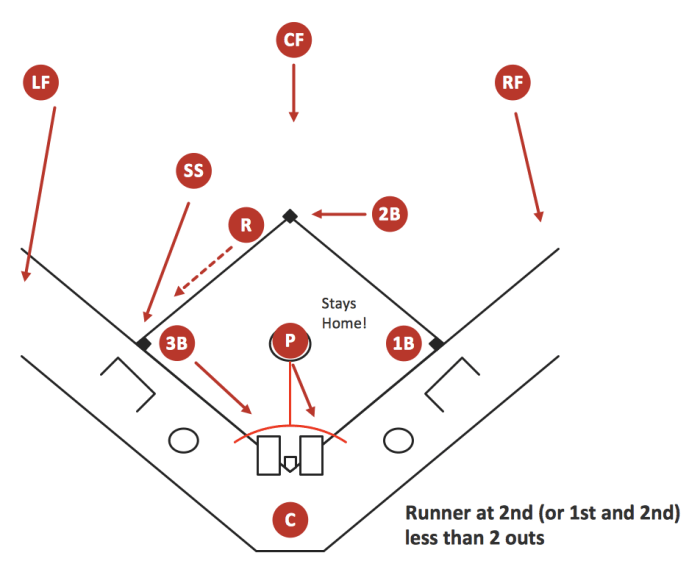Bunt defense runner on 1st – In the realm of baseball, where quick thinking and strategic maneuvers reign supreme, the bunt defense runner on first presents a unique challenge. This article delves into the intricacies of this defensive formation, providing a comprehensive guide to positioning, communication, adjustments, runner management, and practice techniques.
As the pitcher winds up to deliver the pitch, the defense shifts into a specialized alignment, each player assuming their designated role in the intricate web of defense. The pitcher, catcher, and infielders communicate seamlessly through a series of signals, anticipating the batter’s intentions and adjusting their positions accordingly.
Defensive Positioning: Bunt Defense Runner On 1st

In a bunt defense scenario with a runner on first base, the defensive alignment aims to prevent the runner from advancing and force an out at first base.
With a runner on first, the bunt defense is crucial to prevent the runner from advancing. The key is to field the bunt cleanly and throw to first base quickly. If the bunt is fielded cleanly, the runner will be forced to stay at first base, giving the defense time to get the out at second or third base.
Larson v St Francis Hotel is a case that highlights the importance of fielding the bunt cleanly. In this case, the plaintiff was injured when a bunt was not fielded cleanly, allowing the runner to advance to second base and eventually score.
The court found that the hotel was negligent in not providing adequate training to its employees on how to field a bunt cleanly.
The pitcher, catcher, and infielders each have specific responsibilities to execute this defense effectively.
Pitcher
- Positions themselves in front of the mound, closer to first base.
- Covers first base and fields any bunts hit towards that area.
Catcher
- Stands slightly behind home plate, closer to the first base line.
- Backs up the pitcher in covering first base and fields bunts hit towards home plate.
Infielders
- The first baseman positions themselves close to first base, ready to receive throws from the pitcher or catcher.
- The second baseman and shortstop shift towards the first base side of the infield to cover potential bunts.
- The third baseman plays deeper to cover any potential bunt attempts that go past the infielders.
The following diagram illustrates the ideal defensive alignment for a bunt defense with a runner on first base:
| Position | Responsibilities |
|---|---|
| Pitcher | Covers first base, fields bunts towards first base |
| Catcher | Backs up pitcher, fields bunts towards home plate |
| First Baseman | Receives throws from pitcher or catcher |
| Second Baseman | Shifts towards first base, covers potential bunts |
| Shortstop | Shifts towards first base, covers potential bunts |
| Third Baseman | Plays deeper, covers potential bunts past infielders |
Communication and Signals

During a bunt defense, effective communication is crucial to ensure a coordinated response from the pitcher, catcher, and infielders. A clear system of signals allows for seamless execution of the defensive strategy.
The pitcher is responsible for initiating the signals. They will typically use hand gestures or verbal cues to convey the defensive alignment. The catcher will relay these signals to the infielders, who will adjust their positions accordingly. For example, the pitcher may signal for a “bunt defense” by extending their right arm with their fist clenched, indicating that the infielders should move closer to the infield.
Common Signals and Actions
- Bunt Defense:Pitcher extends right arm with fist clenched. Infielders move closer to the infield.
- Infield Fly:Catcher extends both arms overhead, palms up. Infielders raise their gloves above their heads.
- Suicide Squeeze:Catcher touches their glove to the ground behind home plate. Runner on first breaks for home.
- Force Play at Second:Catcher touches their glove to the ground in front of home plate. Second baseman covers second base.
- Force Play at Third:Catcher touches their glove to the ground in front of third base. Third baseman covers third base.
Defensive Adjustments

The defense can make several adjustments based on the batter’s stance, swing tendencies, and the count. These adjustments can help the defense anticipate the batter’s intentions and position themselves accordingly.
Adjustments Based on Batter’s Stance, Bunt defense runner on 1st
The batter’s stance can provide clues about their swing tendencies. For example, a batter who stands with their feet wide apart and their weight shifted back is likely to be a power hitter. The defense can adjust by playing deeper in the outfield and bringing the infielders in closer to the plate.
Adjustments Based on Batter’s Swing Tendencies
The batter’s swing tendencies can also be used to make defensive adjustments. For example, a batter who is known for hitting ground balls can be defended by playing more infielders on the ground. A batter who is known for hitting fly balls can be defended by playing more outfielders in the outfield.
Adjustments Based on the Count
The count can also affect the defense’s positioning. For example, if the count is 3-0, the batter is more likely to swing at the next pitch. The defense can adjust by playing more aggressively, such as bringing the infielders in closer to the plate or playing a shift.
Runner Management

During a bunt defense, managing the runner on first base is crucial to prevent them from advancing. The first baseman and shortstop play vital roles in keeping the runner in check.
First Baseman’s Role
The first baseman must be alert and ready to field bunts or throws from the catcher. They should position themselves close to the bag, allowing them to quickly tag the runner or throw to second base if the ball is hit past them.
Shortstop’s Role
The shortstop covers the area behind the first baseman and is responsible for fielding bunts that go past the first baseman. They should also be ready to back up the first baseman on throws to second base.
Pickoff Attempts and Other Tactics
The defense can use pickoff attempts to keep the runner close to first base. The pitcher can step off the mound and throw to the first baseman, who will attempt to tag the runner. Other tactics, such as fake throws or intentional walks, can also be used to disrupt the runner’s timing and prevent them from stealing second base.
Execution and Practice

Executing a successful bunt defense requires meticulous practice and repetition. Drills and exercises are crucial for refining defensive skills, enhancing coordination, and fostering teamwork. Regular practice sessions allow players to develop muscle memory, anticipate offensive tactics, and execute plays seamlessly.
Drills and Exercises
- Bunt Defense Drill:Simulates game-like situations, with players fielding bunts from live batters. This drill improves fielding skills, communication, and quick decision-making.
- Covering First Base Drill:Focuses on the proper footwork and techniques for covering first base on a bunt. Players practice fielding bunts, throwing to first base, and tagging runners.
- Fielding Pop-Ups Drill:Teaches players to track and field pop-ups in shallow outfield areas. This drill is essential for preventing runners from advancing on bunts that go into the air.
Tips for Effective Practice Sessions
- Realistic Scenarios:Create practice drills that mimic real-game situations, including runners on base and different bunting techniques.
- Progressive Difficulty:Gradually increase the difficulty of drills over time, challenging players and fostering continuous improvement.
- Feedback and Analysis:Provide constructive feedback to players, analyzing their performance and identifying areas for improvement.
li> Game-Speed Simulation:Use live batters and simulate game-speed situations to prepare players for the intensity and pressure of a real game.
Query Resolution
What is the primary objective of a bunt defense with a runner on first?
To prevent the runner from advancing and potentially scoring a run.
What is the role of the first baseman in a bunt defense?
To field bunts hit to the right side of the infield and prevent the runner from advancing to second.
How can the defense anticipate the batter’s intentions during a bunt defense?
By observing the batter’s stance, swing tendencies, and the count.